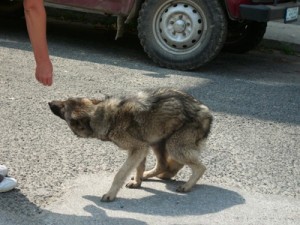Murphy’s chemo
By Helen Burns | Dated June 24, 2021 | 0 Comments
Right at the end of April the gorgeous Murphy came in to see us for his annual vaccination and check up. Little did we or his lovely family know that […]
By John Morgan | Dated August 18, 2015
Dogs feel pain for many different reasons. As a pet owner you are the best person to notice when your dog is in pain. The signs may be subtle and it can often be tricky to identify where they are painful and the cause. It is important to promptly seek advice from your vet so they can determine the cause and appropriately treat it. Below are 8 signs your dog may show if he is in pain:
1. Increased Vocalisation
Dogs often communicate that they are in pain by making more noise. This is the closest thing they have to speaking! Vocalising can be in the form of whimpering, yelping, groaning, grunting, whining and howling. It is often hard to know why they are in pain but if they cry when a certain area of their body is touched then it is most likely to be the sore spot.
2. Panting
Panting excessively is a common sign that a dog is in pain. The breathing can be faster, with shallower breaths. Sometimes the panting is accompanied by trembling. If your dog is panting at odd times such as the middle of the night, or not after exercise or heat, pay attention and look for a cause of the pain.
3. Posture Changes
When a dog is in pain they often assume a different stance. These include the “prayer position” with their front legs on the ground, their rear end up in the air and a stretched out middle. Another position is a rigid, “sawhorse-type” stance. Changes in posture can be even more subtle, such as an arched or sunken back, or a dropped/tucked tail in a dog who normally has a perky/upwards tail.

When a dog needs dog pain treatment they often assume a different stance. These include the “prayer position” with their front legs on the ground, their rear end up in the air and a stretched out middle.
4. Change in Temperament & Behaviour
A dog that is normally friendly can become aggressive or try to bite when they are in pain. This is especially if they are touched in a painful area. It is important to be very careful. Some dogs become less social – withdrawing from their family and hiding due to pain, while others start to seek constant affection and attention from their family. It is very individual. Other changes in behaviour include not wanting to go upstairs, exercise for as long or jump onto furniture. A dog’s toilet habits can also be affected by pain. For example, back pain can cause difficulty with defecation as it hurts them to pass faeces, resulting in constipation.
5. Limping
Limping is an obvious sign that a dog is in pain. Dogs become lame and limp for many reasons, mostly all of them related to pain. As dogs get older, many will experience degenerative arthritis which causes painful stiffness and limping.
Why does my dog constantly groan, it always seems to be when he is lying on his left side thanks annette sirrell
I was dog sitting and noticed one dog was dragging each ear along my rugs, she was also constantly licking her back paws and growning when scratching her neck. It was heart breaking watching her.
I sprayed diluted Apple cider vinegar mixed with a little water on her paws then took her to the vet…
The vet sqeezed her anal glands it really smelt 🤢 and did a test on her ears. Both ears had a very bad infection 😢
The vet gave me ear drops and tablets for the iching, Within 4 hours she was a different dog running around and very happy, she also did a poop 3 times larger than normal 😳 Her paws are now my concern, would she have been licking her paws because of her pain ?😢
Mi perra no para de jadear y de lamerme todo el tiempo. Y a comenzado a orinar con sangre. Pero me dijeron q era embarazo psicológico…lleva semanas así y no se q hacer. Ojalá puedas ayudarme. De antemano muchas gracias